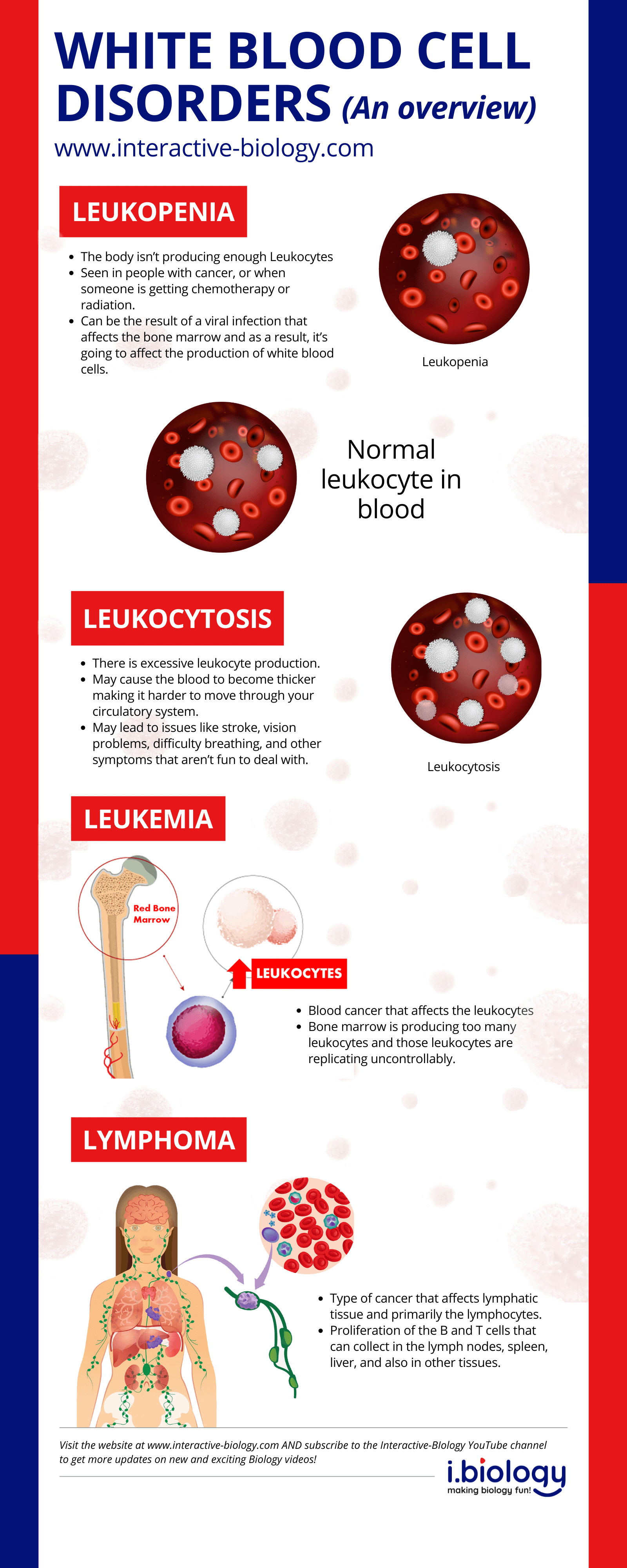Leukocytes or White Blood cells are very important cells in your blood. They function primarily as the defenders of the body, protecting your body when things go wrong or when foreign invaders like bacteria or parasites try to cause problems.
But what happens when things go wrong with these leukocytes?
Topic Outline:
Because leukocytes play such a vital function in the immune system, it’s important for us to have the right amount of leukocytes in the blood.
As I mentioned in the last video, in a typical adult human, you’d find that we have around 5,000 – 10,000 white blood cells in one microliter of blood. Depending on what’s going on in the body, you might have higher amounts of leukocytes.

Let’s say you’re fighting off an infection. Well, you’d expect the body to produce more specific types of leukocytes in order to help to fix that situation. That’s a normal response.
White Blood Cell Disorders
Now in some cases, you can have disorders that affect leukocytes directly.
Leukopenia
For example, if the body isn’t producing enough Leukocytes in order for your immune system to function properly, that condition is called leukopenia.

Since leukocytes have immune functions, that could make an individual more prone to becoming ill. And that’s obviously not a good thing. Sometimes we see this in people with autoimmune diseases.
Sometimes this is seen with certain types of cancer, or when someone is getting chemotherapy or radiation. Or it can be the result of a viral infection that affects the bone marrow and as a result, it’s going to affect the production of white blood cells.
The key thing here is this: There are not enough white blood cells to do what they’re supposed to do and the result is that that person’s immune system function is compromised.
Leukocytosis
On the other hand, we can have excessive leukocyte production and that’s called leukocytosis.

Now, you might think that since these cells are the defenders of the body, having more is a good thing, right?
Maybe now you’d have a super-strong immune system that could fight off anything. But then you’d be wrong. You don’t want to have too many for a few reasons.
The first is that it can make your blood thicker. And thicker blood is harder to move through your circulatory system. It can put a strain on your system and lead to issues like stroke, vision problems, difficulty breathing, and other symptoms that aren’t fun to deal with.
But the thickness is not the only thing. Sometimes yes – you have excessive leukocyte production, but often times many of the cells can be nonfunctional. And now once again you have a situation where even though you have a bunch of white blood cells, there’s an increased risk of disease similar to what you have with leukopenia.
The key thing here is balance, you want to have a white blood cell count that’s in the right range and you want them to be functional so that you can have the protection you need.
Leukemia
Leukemia is a blood cancer that affects the leukocytes – the white blood cells. What we’re usually dealing with here is the bone marrow is producing too many leukocytes and those leukocytes are replicating uncontrollably.

The production of our body cells is usually a tightly controlled process. There are certain proteins that regulate this process. If there’s a mutation in the proteins that control this process, there can be uncontrolled cell division and excessive production of leukocytes.
Chronic and Acute Leukemia
Leukemia can be chronic or acute.
- In chronic leukemia, we get a large number of mature leukocytes that just keep accumulating.

- With acute leukemia, we have a situation where the leukocytes don’t fully mature. So now you have a bunch of immature blood cells.

Whether we’re dealing with acute or chronic leukemia, we have a situation where the cells don’t do what they’re supposed to do and we get a bunch of complications.
Lymphoma
Then there’s lymphoma. As the name suggests this is a type of cancer that affects lymphatic tissue and primarily the lymphocytes.
We get a proliferation of the B and T cells that can collect in the lymph nodes, spleen, liver, and also in other tissues.

Just like with leukemia, we have a situation where these malignant leukocytes don’t do what they’re supposed to do and the person is much more vulnerable to infection because the immune system isn’t working optimally.
Now, this just scratches the surface of the disorders that affect leukocytes, and as we continue on in this series, we’ll encounter more of the details.
You’ll see that there are different types of leukemia and lymphoma, how they are diagnosed, and a bunch of other key details.
For now, I just wanted to give you an overview of the disorders that affect leukocytes.
That’s it for now, and I’ll see you in the next video.
Infographic

